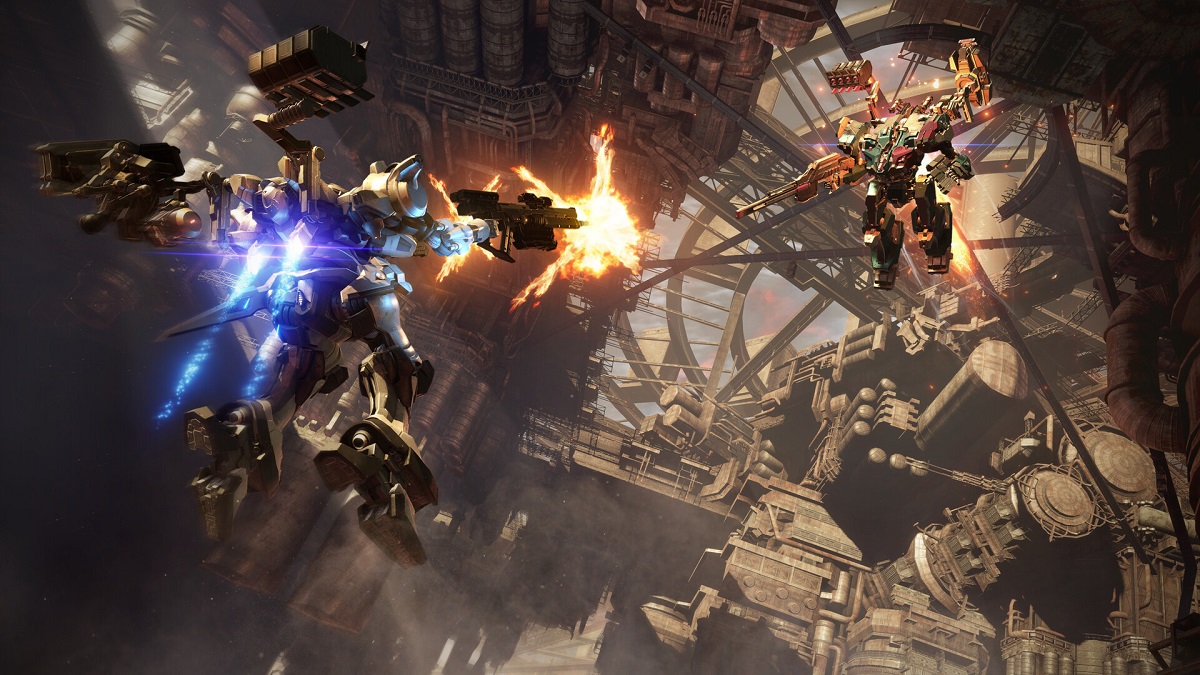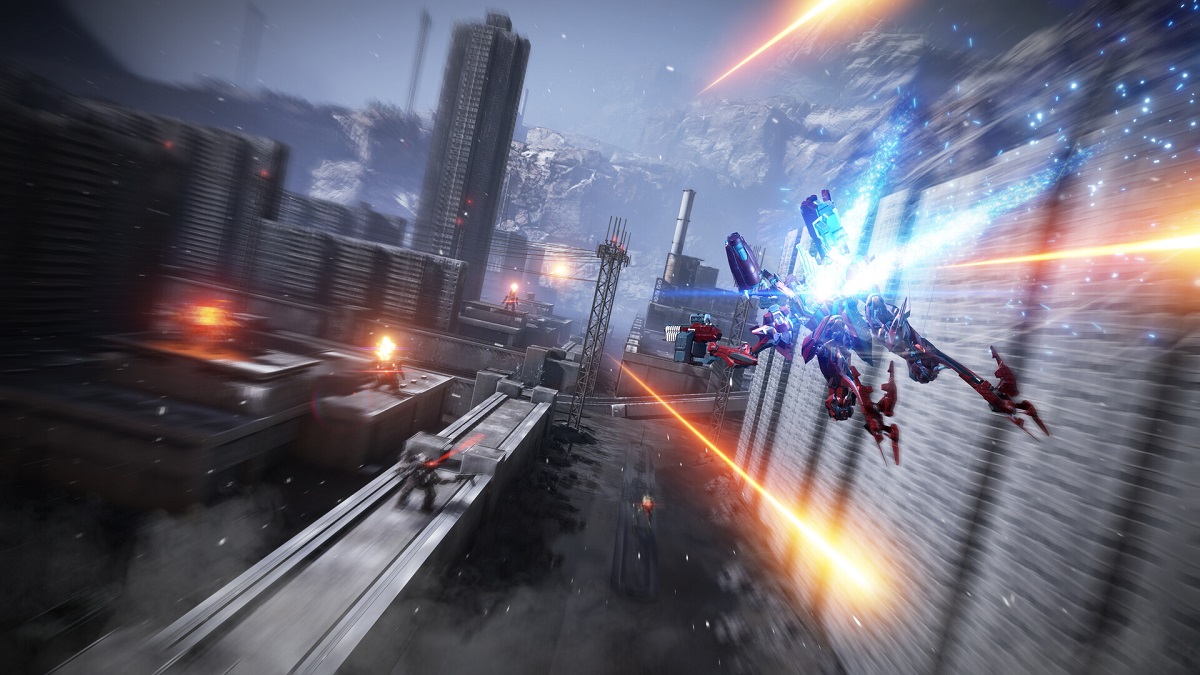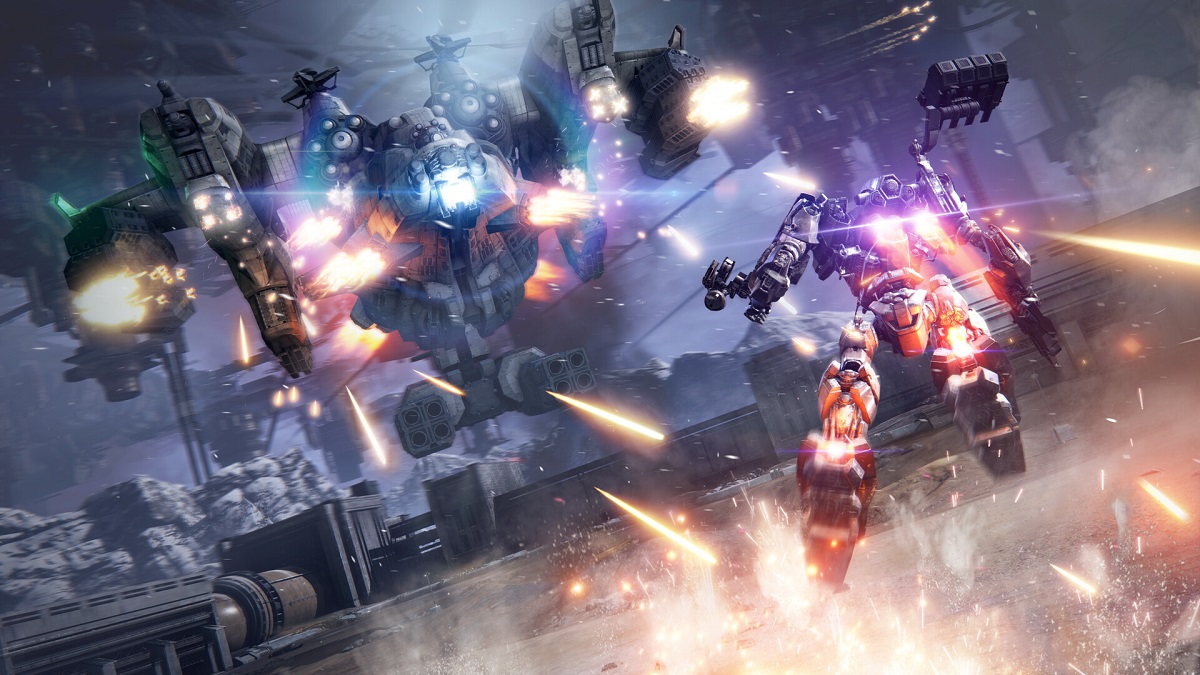Aesthetics matter. Especially in video games, where the words “vibe,” “immersion,” and, of course, “atmosphere” get thrown around like rice at a wedding (don’t do that by the way, it’s bad for the birds).
Aesthetics are perhaps what Armored Core VI: Fires of Rubicon does best. It does, after all, stylize its own title in ALL CAPS on any official pressers. Aesthetics don’t have to be traditionally beautiful but can be in their desolation or their mundanity. Armored Core VI comes in all shades of grey and beige, but you can’t deny the allure of its sheer commitment to the cold, dead atmosphere of planet Rubicon. In its drabness, too, Armored Core VI lays a canvas for the rarer splashes of vibrancy. The bright oranges and blues of thrusters and laser swords penetrate the undersaturated screen like drops of blood on a bathroom sink.
You play as Augmented Human 621 — a number you’ll be hearing ceaselessly from your Handler, Walter. I’m no aficionado — this is my first Armored Core game — but I presume Handlers source their pilots for augmentation from places like prisons, work camps, and dredge heaps. You’re fighting for nothing but a purpose, and Walter has big plans for you — just don’t ask what they are.
The story of Armored Core VI is actually quite compelling. It has all the political intrigue of a great space opera, with a multitude of factions, allegiances, double-crosses, and memorable figures. You’ll fight for one of the two corporations seeking to siphon Rubicon’s precious and mysterious resource — the Coral. Arquebus and Balam both use you as a bludgeon against each other like kids taking turns hitting each other with the same big stick.

The back-and-forth of these two corps sending you after one another almost gives the affair a Looney-Tunes-esque feeling of inconsequence, but that’s just the reality of being a mercenary for hire. Nobody takes it personally when you cross them mid-mission: they got outbid, and that’s the cost of doing business.
Each corporation and faction has a few key figures. A fan-favorite is sure to be Arquebus’ own in-house merc “Rusty,” who calls the player “buddy” every other breath. He’s a key figure throughout the game, and like many others, his allegiances and motives are more complex than meets the eye. Everyone is fighting for something, even the corporations’ most die-hard members.
Missions in Armored Core VI are deceptive, at first. After watching some early preview coverage I couldn’t help but feel that in an effort to avoid spoilers, FromSoft had done themselves a big disservice showing only the early hours of the game. These initial missions are worryingly brief, easy, and inconsequential. I was blasting through the first hour or two of the game, wondering, “Is that it?” Luckily, by Chapter 2 mission variety increases significantly, with increased length, varied objectives, and even forking paths for you to choose which unlock even more missions for replay later on.
Missions begin with briefings, outlining the objective of your outing along with some flavor via comms with either the hiring entity, their subsidiary, or both. Arquebus, for example, uses the subsidiary merc group Vespers, while Balam uses the Redguns. These subsidiaries have their own key figures, who have relationships with each other as well as Walter, leading to some great character moments and a whole lot of world-building.

During the briefing, you’ll be given clues as to what kind of mission you’re about to take on. Is it indoors or out? Are the targets plentiful and weak, or few and heavily armored? Is it a defense or escort mission? All these clues will lead you into the garage, where customizing your mech down to the last decal will ultimately determine how difficult the mission is going to be. If you bring a lightly armored, close-range AC to a heavily-fortified base in hopes of wiping it out, you might as well turn around early and get back to the drawing board.
This loop of “attempt -> evaluate -> iterate” is the beating heart of Armored Core VI. Even beating a mission means there’s room to improve via the graded replay system. Getting an S rank on a given outing means having a highly-optimized AC as well as a thoughtfully-planned route, and it can be addicting to chase. I spent hours replaying missions not only trying for higher grades but also seeking out hidden caches of AC parts and Combat Logs which dropped from more dangerous foes sprinkled throughout certain missions.
Replayability doesn’t just come in the form of re-doing missions, either. There are three distinct “routes” in Armored Core VI which each have their own brand new missions, story beats, AC parts, and endings. Playing through the entire story again may sound like a chore, but there’s just enough new stuff throughout to have made it feel very worthwhile. I do wish some things were a little more brisk, however. Those short early missions really start to feel like a drag on repeat playthroughs of the story, as they all end right as you’re getting warmed up.
But replays are worth it, if not for new missions and unlocks then for more story, which I consider a surprising high-point of the game. The mystery of Rubicon’s Coral isn’t as obfuscated as the lore of say, Elden Ring, but I still found myself wanting answers after each ending, so I pushed on. You have this sense that there’s simply a better way — a better future for this dying world and its people, outside the power dynamics of the corporations and the Planetary Closure Administration.

Let me touch on the boss encounters of Armored Core VI. It’s not “like Dark Souls,” but damn do these bosses hit a little close to the feelings given by those. There’s basically an Ornstein and Smough. There’s basically an Artorius. There’s almost a Havel the Rock. I won’t spoil anything here, but these are the highlights of the game. They’re each memorable, singular encounters that put your ability to build and pilot an AC to the test.
This is all to say nothing of the Arena which, while not particularly challenging, is yet another way to unlock parts, decals, and entire armored core blueprints (given you’ve unlocked the parts). The feeling of swapping around some parts on your AC and it handling like an entirely different beast is a remarkable one that I never tired of. Further customizing the color scheme and decals (and even making your own via the editor) just adds to that feeling of ownership over your craft, and I grew very attached to my handful of tried-and-true ACs by the end of my third playthrough, which came in at around 45 hours.
Armored Core VI: Fires of Rubicon is a niche game. It’s also a niche game that scratched itches I didn’t even know I had: one for a Metal Gear-style story of political intrigue, another for mech customization, and one for frenetic, fast-paced combat that required mastery of a multitude of systems. I adored my time with it, and I’ll be heading back for more to live vicariously through all of you who will be experiencing it for the very first time.
This review is based on the PC version of the game. A code was provided for review by Bandai Namco.
Fantastic
Armored Core is like getting to put together your own giant Lego robot and sending it out to die before realizing you just needed to attach a few more missile launchers. Freedom in gameplay comes in many shapes and sizes, and the customization of your very own mechs suited to each mission is a niche yet thrilling experience. A thoughtful, intricately-woven story and amazing presentation sure don't hurt, either.
Armored Core VI: Fires of Rubicon
